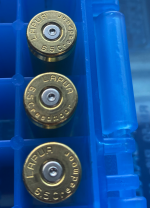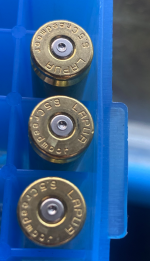Thanks for sharing this. Couple of clarifications 1) why are these numbers diff from the chart you shared earlier. The MV numbers in this chart match more closely to what I am seeing in my reloads 2) I have bought down my charge to 41.2 grain. Based on this chart, I should expect close to 59k psi. How do I check if that is safe amount of pressure.
@Mike Casselton : request pitch in as well. thanks
There are so many different things that can cause different pressure readings, but I'll try and touch on a few for entertainment purposes.
1. Brass brand and the weight of the brass.
Hornady has two distinctly different weights of 6.5 CM brass. IIRC, its about 7-8gr difference.
2. Primer type, brand and specific primers within that brand. CCI 400 vs 450 for example.
3. Projectile used and the shape of that projectile relative to bearing surface. Also add in if the bullet is cup and core vs monolithic.
4. Ambient temperature.
5. Ammunition temperature. Yes, we had to test our ammo at temperature extremes (hot and cold) to be within SAAMI specifications.
6. Number of firings on brass. Yes, it work hardens and it will not show pressure signs as well once it starts to harden.
7. Brass length at the neck. If it's too long, it will pinch the projectile when it's chambered and spike pressures. Some cartridges you can actually feel when the case mouth contacts the end of the chamber.
8. Seating depth.
9. Chamber freebore.
10. The leade angle of the throat.
11. Relative humidity. We're talking extremes here where you can feel the moisture on the brass. For some reason, it'll cause a lot of cracked necks. I've tested this on multiple occasions, and a simple wipe with a dry towel will eliminate it. (Yaaaay, for living in Florida)
12. Barrel cleanliness with respect to carbon rings.
Carbon rings will increase pressure by a large margin.
13. Barrel/chamber temperature.
14. Powder charge and the type of powder used.
15. The type of powder must be correct with respect to the cartridge and bullet weight being used. Take the time to look at some manufacturers load data.
If you pay attention, you might notice powder A is good up to 130gr bullets, but there is no data for heavier projectiles.
You might also see that powder B is only good for 130gr to 154gr.
Powder C might work with all weights, but not be the best for accuracy.
Powder D might be the best with accuracy, but not give the highest velocity.
You as the handloader need to decide which things are most important.
For me, primary importance is SAFETY.
Second is accuracy and reliability.
Velocity comes in a distant 3rd place.
Take your shooting app/calculator and enter your longest distance you shoot.
Zero wind for conversation sake.
Then, write down your come up for that distance.
Now, drop your velocity by 100fps and write that come up right next to it.
Drop it another 100.
Play around with those numbers and you'll see that it's not that big of a deal.
What is a big deal is accuracy and reliability.
Here's some screen shots of a 7-STW shooting a 190 A-Tip at a 1-Mile target.
I start the velocity at 3020, then drop it to 2920, then 2820 just to show how small the effect is, even at a mile.
I don't know what distances you shoot, but 200fps slower is only 3 Mils at a mile.
If you're shooting PRS distances, I'd bet that 200fps would be around 1.5 Mil.




